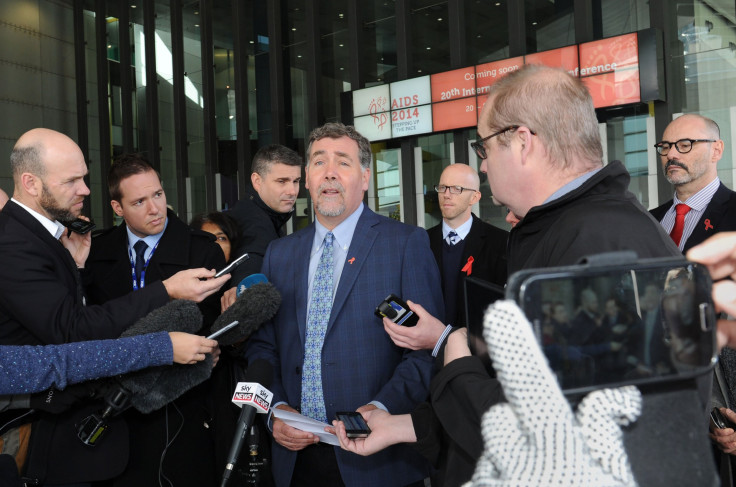AIDS Experts Of Flight MH17: Cure For Virus ‘May Have Been On That Plane’

UPDATE 7/21/2014: While initial estimates put the number of AIDS researchers killed in the crash of Malaysia Airlines Flight MH17 at over 100, the International AIDS Society confirmed Saturday the identities of six delegates – not 100 or more – traveling to the 20th International AIDS Conference in Melbourne, Australia. This article has been corrected to reflect this change.
The stunning loss of scientific intelligence and knowledge as a result of the crash of Malaysia Airlines Flight 17 is unprecedented, and its impact on the search for a cure for HIV/AIDS will likely be felt for years to come. Officials cofirmed that six of the 298 passengers aboard the plane were top HIV/AIDS scientists and researchers en route to the International AIDS Conference in Melbourne, Australia, which begins Sunday.
Those in the field of AIDS research lament not just their deaths, but the loss of their expertise and the vast wealth of knowledge they held. Though the exact number of HIV/AIDS scientists and researchers who died when the plane was shot down near Grabovo, Ukraine, on Thursday hasn't been released, the International Aids Society confirmed Saturday the identities of six of those delegates.
“We do know that there were a lot of people [on flight MH17] who were working in AIDS research,” Nora Restrepo, a spokeswoman for UNAIDS, the HIV/AIDS research branch of the United Nations, told International Business Times. But, “we’re still essentially bracing ourselves to hear how many people were on that flight.”
Michel Sidibé, executive director of UNAIDS, said in a statement that the organization is “in deep shock. … The deaths of so many committed people working against HIV will be a great loss for the AIDS response.”
The identities of six of those AIDS researchers were confirmed Saturday and included World Health Organization spokesman Glenn Thomas and former president of the International AIDS Society Joep Lange. In 2001, Lange founded the Amsterdam-based nonprofit organization PharmAccess Foundation, which helps people in developing countries gain access to HIV/AIDS therapy. "Joep was a visionary amongst HIV researchers," Richard Elion, an American HIV researcher, told Vox News. "He was acutely aware of the multiple dimensions of HIV spanning science to society and had a heart of gold."
The deaths of activists like Joep, whose knowledge and experience in AIDS research is considered irreplaceable, has led many to wonder about the ramifications of losing such intellectual capital in the global movement to end AIDS, which has killed an estimated 36 million people worldwide since the disease surfaced in 1981, according to the WHO.
“That knowledge is irreplaceable,” Richard Boyd, director of the Monash Immunology and Stem Cell Laboratories, told Guardian Australia. "We've lost global leaders and also some bright young people who were coming through.” It's not only the individuals' knowledge that was lost; so, too, were their capabilities to connect the dots in scientific research.
Trevor Stratton, an HIV/Aids consultant, said it's hard to overstate the importance of the loss. He told ABC network that “the cure for AIDS may have been on that plane.”
Massimo Ghidinelli, head of Pan American Health Organization’s HIV and STD research unit, stressed that while the loss will be keenly felt, those on the plane had shared much of their knowledge. “Certainly professor Lang and many others were actively collaborating on the quest for a cure for AIDS,” Ghidinelli told IBTimes. “Luckily, it was not all imbedded in one single group.”
Ghidinelli added that information about the latest developments in AIDS research is usually shared among those in the global AIDS research community, and that there are “several promising strains” of work going on all over the world.
Still, he said, “The big loss is the human loss and the individual loss of contribution that all of those brains have contributed to the HIV AIDS community over the years. I don’t know the details, but I have a fear and a major concern of most of the Amsterdam-based research group might be heavily affected by this tragedy.”
Nobel laureate Françoise Barré-Sinoussi, who co-discovered the AIDS virus, has said the AIDS conference in Melbourne will continue as planned. The conference will feature such prominent AIDS activists as former U.S. President Bill Clinton and Sidibé.
On Friday, President Barack Obama noted that the victims included “nearly 100” AIDS researchers, though the Washington Post reported that conference organizers had confirmed only seven names.
“We have been working hard to try and confirm how many people were on the flight. We’ve been speaking to a number of different authorities, and we think the actual number is much smaller,” Chris Beyrer, who will take over the presidency of the International AIDS Society at the end of the global conference next week, told the Post.
Among the others the Post reported to have been confirmed by employers or others to have been on the flight were three Dutch AIDS activists: Lucie van Mens, who had been involved in HIV/AIDS prevention work; Martine de Schutter, a program manager at Bridging the Gaps, which lobbies for universal access to HIV prevention; and Pim de Kuijer, a lobbyist at the group Stop AIDS Now.
In an email to the Washington Post, Oyuntungalag Namjilsuren, a colleague of Thomas' at WHO, called the tragedy “a shell shocking event in global aids response.”
© Copyright IBTimes 2024. All rights reserved.






















